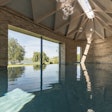
 Photos courtesy Brett Stanley
Photos courtesy Brett Stanley
Brett Stanley, a photographer specializing in underwater shots, uses water’s unique properties to bring dreamlike scenes to life.
“Underwater photography is unique in that it’s an almost weightless environment, giving you the ability to create images that would be almost impossible on land,” says Stanley. “Water also lends a softening quality that I find very surreal.”
Stanley transitioned from commercial photography to an underwater specialization in 2013, after he moved to the U.S. from New Zealand.
“I began shooting underwater because I wanted to see what could be done there that I hadn’t seen before. It’s a place of unique possibilities, and it’s also where I feel my photography skills are at their peak,” he says.
But it’s no easy feat: capturing images below the surface, apparently, is three times as difficult as shooting on dry land. “We need to consider the safety aspects as well as how to achieve the look we’re after. Lighting is also difficult, as you need special waterproof lights if you need to submerge them.”
Stanley’s clients range from everyday people interested in the experience to musicians seeking album covers. Using Canon cameras and lenses, he shoots primarily in swimming pools and tanks, as those spaces offer some degree of control.
“[It’s] much easier — it’s like a traditional studio, where you can include a backdrop or even build whole sets,” he says.
In fact, Stanley hired a contractor to build a custom pool/studio at his property in Los Angeles. “I wanted it as a studio, obviously, but I didn’t want to create something that was useless as a swimming pool if we ever sold it, so I designed it to be the best of both worlds,” he explains. “I used a white plaster and white tile trim to replicate the walls of a photographic studio, and incorporated features in the concrete deck that would facilitate my lighting. It turned out great, and I love shooting in there.”
In a display of sheer commitment to his vision, Stanley actually ended up doing some of the manual labor himself. “I wanted the pool to be rather deep. We aimed for 10 feet, but the length of the pool and the sharp drop meant the digger equipment couldn’t physically get in to dig past 8 feet…so, I spent a few days digging out another foot by hand.”
For Stanley’s latest work, follow him on Instagram @brettsphoto or visit brettstanley.com.
This article first appeared in the April 2022 issue of AQUA Magazine — the top resource for retailers, builders and service pros in the pool and spa industry. Subscriptions to the print magazine are free to all industry professionals. Click here to subscribe.












































